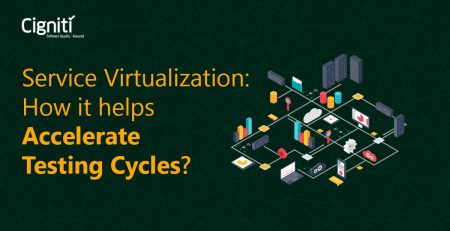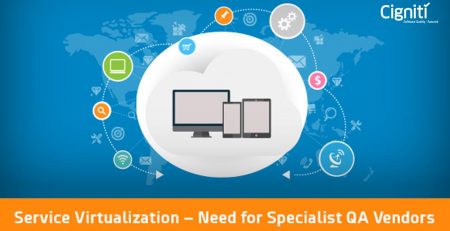Manage Your Test Environment Better Using Service Virtualization
Software solutions and applications cannot be developed in silos without considering the possible consumer / user environment. In the current consumer scenario, it is inevitable to consider all types of scenarios that might arise and pose a challenge for the software/application to execute and operate effectively. It is imperative to break down the silos to build a cohesive and an all-inclusive environment for development. By offering an emulated environment, Service Virtualization (SV) makes this possible for the overall development process.
Service Virtualization is an inventive approach offering developers and testers the space to test their applications in a constantly evolving environment. By adopting this approach, the entire application/database is not virtualized, it is only the behaviour that is required for the testers for used cases is created.
While originally, ‘Service Virtualization’ was conceptualised to direct the focus on emulating web services, the new approach towards SV significantly brings down the configuration time, data management efforts, and hardware overhead required for building up and managing a workable development and testing environment.
Testing Environment Management (TEM) with a boost of Service Virtualization is specifically apt for developing and effectively implementing enterprise class solutions and applications. As the testers on the project keep varying and at the same time the testing environment keeps on evolving constantly, there is a need to set up and manage a Testing Environment.
Moreover, dedicated Test Environment Management enables organizations to cut down on costs, achieve faster time-to-market, and meet desired quality standards.
Challenges in Test Environment Management
TEM offers developers a steady test environment for testing software/applications in a LIVE production environment and replicate bugs. These Test Environments need to be managed and kept up to speed with the sheer purpose to get the desired outcome and meet the testing requirements.
It is estimated and validated by experts; a major issue that teams face with their testing environments is its management, which consumes approximately 40% of software development efforts.
Following is a list of a few key challenges faced in the management of a test environment:
- Regulation of test environments for serving ongoing and future projects
- Implementing accurate capacity and forecasting demands
- Creating a testing environment with heterogeneous assets
- Effective resource allocation process and standards
- Responsive, adequate support for any probable issues in the test environment
- Consistently taking up onus for any activity in the test environment
It is observed that when the software development scenario starts getting complex, enterprises are pushed to choose between time and quality. However, Test Environment Management can be maintained even in this scenario, where some simple steps / practices can be adopted to keep up the quality and stability of the test environment.
Best practices by experts recommend that the initial step to build a sustainable TEM is to assign the ownership to an individual, team, or function. If the ownership is shared, it leads to chaos and mismanagement. Most importantly, it provides a single point of contact for people across the organization.
Benefits of Test Environment Management in Software production
Every investment is expected to produce an optimal ROI. Enterprises invest substantially in the development and sustenance of an effective and responsive test environment. So, it is essential to understand the best practises to seek the desired outcomes, namely, enhanced software quality, faster turnaround time, and quicker time-to-market.
Encapsulating and comprehending it further:
- Rational selection and optimization of test assets brings down the testing cost
- Standardized procedures for allocation and provision of test capabilities, test automation reduces testing time
- A resourceful TEM team can optimize test requirements and test cases
- A dedicated TEM team can develop test strategies and tools to enhance test coverage and quality
- TEM facilitates the project test teams with acquisition, analysis, processing, and deployment of production-level data essential for conducting tests during the initial stages of development.
Environment Virtualization
Speaking of Environment Virtualization, Service Virtualization enables organizations at the infrastructure level, where any of the VMWARE compatible images can be made available on the cloud. Cloud services can be leveraged by enhancing scalability as per the requirement.
Unlike physical test environment labs, TEM in Cloud deconstructs the complexity of Test Environment configuration and capacity. It leverages the cloud by offering the clients on demand access to the test environments. This is offered without any resource constraints and also brings down the overall expenditure.
Service Virtualization offers an emulated environment with essential components that would be present in the final production environment, which allows complex applications to go through integration testing way ahead in the development process. Moreover, it helps identify and cut down key bottlenecks that could delay production, turnaround time, and time-to-market for an Application Under Test (AUT).
What do we gather?
Specifically, when it comes to developing enterprise applications, the developer has to rely on various system component to work cohesively. This is exactly the space where Service Virtualization fits in the overall Testing ecosystem, wherein scenarios and components are simulated to offer a volatile testing environment.
Furthermore, TEM enables development and QA teams to readily access the specific environment and accelerate the development process. It further identifies test environment issues and helps evaluate its impact on the application at hand.
Is your enterprise is considering to implement a dynamic Test framework and well conceptualised Service Virtualization strategy? Collaborate with Cigniti experts and implement effective SV practices to acquire higher ROI with faster time-to-market.





Leave a Reply